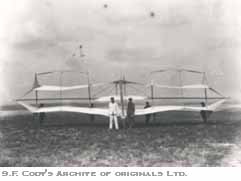In 1905 Cody built a very large but
light biplane glider.
The pilot would lie prone, in a hammock
contraption in the centre of the lower wing,
the machine was sent up as a kite on
a string and then set free to glide
down to the ground. The wing
span was 51 feet (16 metres),
the wing area was 807 square feet (75
square metres).
Its weight when empty was 116lbs and,
with Cody as pilot 320lbs.
It had two small auxiliary control
surfaces, of diamond shape, under the lower wing. These were used
as ailerons for stability,
as elevators for rise and descent and
were called 'elevons'. Later a supplementary elevator or balancing
tail was added to the rear. The pilot moved the 'elevon' cords
with his hands and the rear elevator
with his feet. Despite its size
the glider was easily transported,
capable of being folded down into a
reasonably small area and quickly erected
in twenty minutes.
The glider was built in 1905
at the Crystal Palace,
London when Cody was on leave from
his duties as Kite Instructor
at the Balloon School in Aldershot.
It was there that Sir Hiram Maxim
watched the machine successfully fly.
It was later taken to Jubilee Hill near Aldershot where many more flights
were made with both civilian and Army pilots.
The best glide achieved was 740 feet
(225 metres) with a drop
of 350 feet (107 metres). That
same year the machine crashed
when piloted by Vivian Cody.
There are not many photographs of the
glider. The examples here
show one image of the glider in flight
and the others of the machine held on the ground (including two where the
machine is upside down.)





